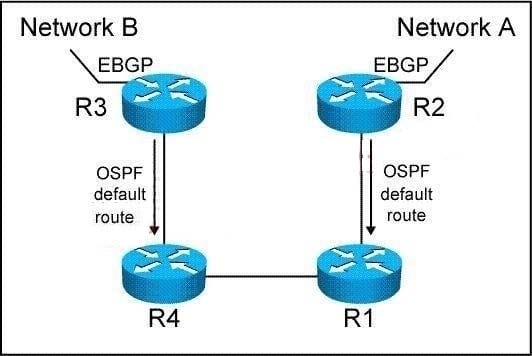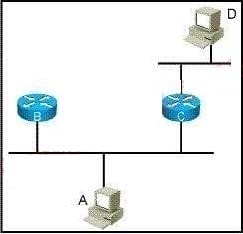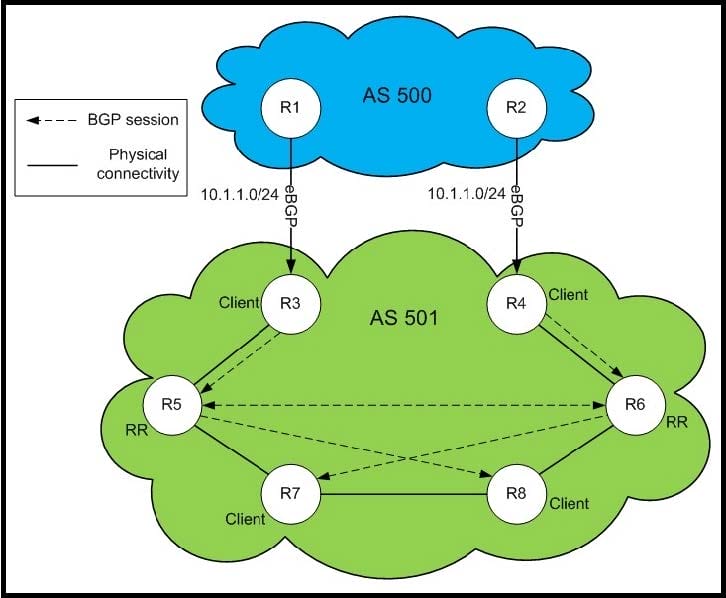Exam Details
Exam Code
:352-001Exam Name
:CCDE WrittenCertification
:Cisco CertificationsVendor
:CiscoTotal Questions
:705 Q&AsLast Updated
:Jul 03, 2023
Cisco Cisco Certifications 352-001 Questions & Answers
-
Question 541:
Refer to the exhibit.

R2 and R3 are running EBGP and are learning Network A and Network B. R2 and R3 are also running IBGP to exchange Network A and Network B. OSPF is IGP. R2 and R3 are advertising default routes. R1 and R4 can send and receive
traffic from Network A and Network B respectively. However, Network A cannot send traffic to Network B.
How can you solve this problem?
A. create a tunnel between R2 and R3
B. create a tunnel between R2 and R4
C. create static default routes pointing from R1 and R4 to R2 and R3, respectively
D. convert R3 and R2 to ABRs so that R1 and R4 can choose the closest ABR to exit the network
-
Question 542:
What are the two preferred mechanisms for detecting Layer 2 link failures quickly? (Choose two.)
A. BFD
B. fast RSVP hellos
C. LDP keepalives
D. loss of signal
-
Question 543:
Your network operations team is deploying Access Control Lists (ACLs) across your Internet gateways. They wish to place an ACL inbound on the Internet gateway interface facing the core network (the "trusted" interface). Which one of these addresses would the ACL need for traffic sourced from the inside interface, to match the source address of the traffic?
A. inside local
B. outside local
C. inside global
D. outside global
-
Question 544:
Refer to the exhibit.

All of these network devices are running IPv6. When host A is attached to this link, how will it discover the presence of routers B and C?
A. Routers B and C will respond to an ICMP get route request sent by host A.
B. Routers B and C will detect the addition of the new host the first time it transmits any packets, and will send an ICMP router discovery reply to host A.
C. Host A will discover routers B and C through the neighbor discovery process.
D. Routers B and C send out periodic gratuitous ARPv6 messages to alert newly attached hosts to their presence.
-
Question 545:
You are the SAN designer for the ABC Company. Due to budget constraints, there is increased pressure by management to further optimize server utilization by implementing virtualization technologies on all servers and increase virtual machines density. Faced with some SAN challenges, the server team requests your help in the design and implementation of the SAN in the new virtualized environment. In which two ways can NPIV be used in your proposed design? (Choose two.)
A. NPIV is used to assign multiple FCIDs to a single N Port.
B. NPIV is used to define and bind multiple virtual WWNs (VIs) to a single physical pWWN.
C. You recommend NPIV so that hosts can be members of different zones.
D. NPIV can be used to allow multiple applications on the same port to use different IDs in the same VSAN.
-
Question 546:
Which two features can be used to extend VRFs across a campus? (Choose two.)
A. 802.1q trunks
B. LDP
C. MPLS TE
D. GRE
E. port channels
-
Question 547:
You have been asked to deploy BGP across a satellite link system to a small number of retail stores.
What must you do to successfully deploy BGP in this situation?
A. configure all the BGP peering sessions across the satellite links as EBGP
B. set the BGP hold timer to under one second
C. configure the initial window size, maximum MTU, and TCP keepalive parameters D. manually configure static routes to back up BGP across the satellite link
-
Question 548:
Your company requires two diverse multihop External Border Gateway Protocol peerings to a partner network.
Which two methods would you use to improve lost peer detection? (Choose two.)
A. Use Bidirectional Forwarding Detection for the peers.
B. Use Selective Address Tracking and match the peers.
C. Use subsecond keepalives for the peers.
D. Use subsecond hold timers for the peers.
E. Use Fast Peering Session Deactivation for the peers.
F. Use subsecond minimum route advertisement Interval timers for the peers.
-
Question 549:
Refer to the exhibit.

In this BGP design, what is the next hop for 10.1.1.0/24 on R8 and R7?
A. The next hop for 10.1.1.0/24 on R7 is R8 and the next hop for R8 is R7.
B. The next hop for 10.1.1.0/24 on R7 is R5 and the next hop for R8 is R6.
C. The next hop for 10.1.1.0/24 on R7 is R6 and the next hop for R8 is R5.
D. The next hop for 10.1.1.0/24 on R7 is R3 and the next hop for R8 is R4.
-
Question 550:
Refer to the exhibit.

What limitations exist in this design, given that the access layer devices are expected to steadily increase by two devices per week for the next year?
A. scalability
B. serviceability
C. redundancy
D. resiliency
Related Exams:
300-915
Developing Solutions using Cisco IoT and Edge Platforms (DEVIOT)300-920
Developing Applications for Cisco Webex and Webex Devices (DEVWBX)352-011
Cisco Certified Design Expert Practical500-052
Cisco Unified Contact Center Express500-173
Designing the FlexPod Solution (FPDESIGN)500-174
Implementing and Administering the FlexPod Solution (FPIMPADM)500-201
Deploying Cisco Service Provider Mobile Backhaul Solutions500-210
SP Optical Technology Field Engineer Representative500-220
Cisco Meraki Solutions Specialist500-230
Cisco Service Provider Routing Field Engineer
Tips on How to Prepare for the Exams
Nowadays, the certification exams become more and more important and required by more and more enterprises when applying for a job. But how to prepare for the exam effectively? How to prepare for the exam in a short time with less efforts? How to get a ideal result and how to find the most reliable resources? Here on Vcedump.com, you will find all the answers. Vcedump.com provide not only Cisco exam questions, answers and explanations but also complete assistance on your exam preparation and certification application. If you are confused on your 352-001 exam preparations and Cisco certification application, do not hesitate to visit our Vcedump.com to find your solutions here.